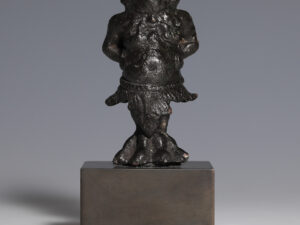Terracotta figurines are the most common sculpture types found across Hellenistic sites. They vary from simple crude figures to finely rendered creations. Although present in a variety of different circumstances, a common usage was as a votive offering in funerary and sanctuary contexts. Terracotta figures were cheap to make and easily replicable, making them well suited for this purpose. As divine objects, it was forbidden to destroy votive items. As a result, sanctuaries and shrines were often packed with such objects and the walls became additional surfaces for display. Many votives were made in a way allowing for them to be hung up, such as the flat back and perforation featured in this example.
The Silenus or Satyr figure was commonplace in Greek mythology. They both presented as wild creatures; half-man, half-animal, and often accompanied the god Dionysus, as they were associated with his cult. . They are often seen pursuing nymphs through the forest, causing mischief, or drinking.



















